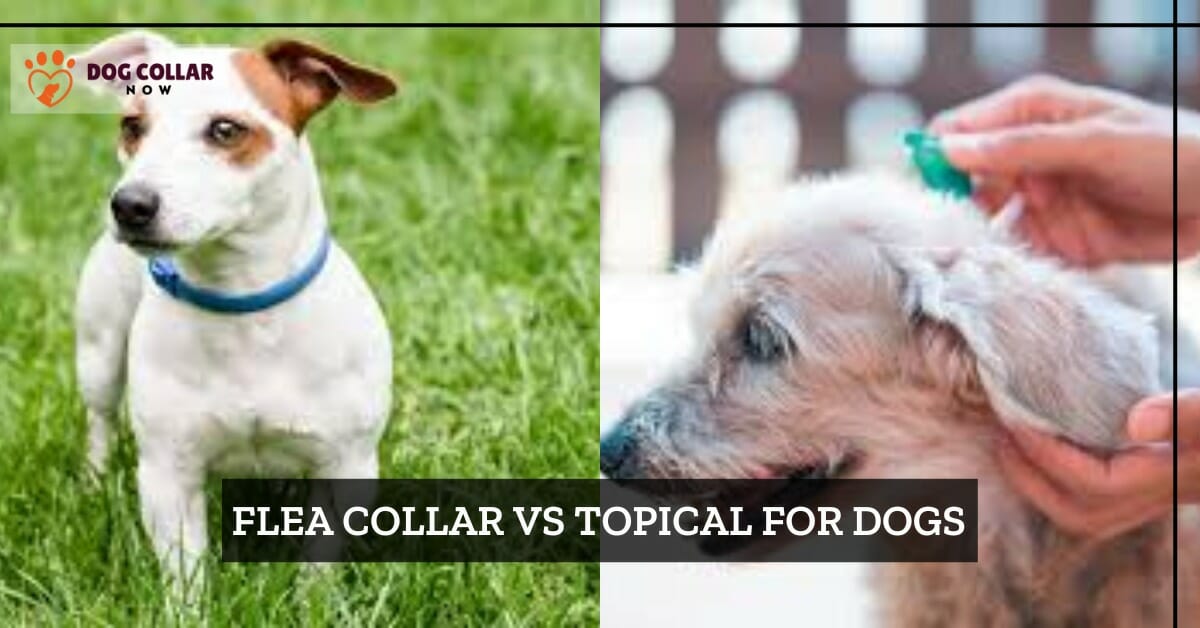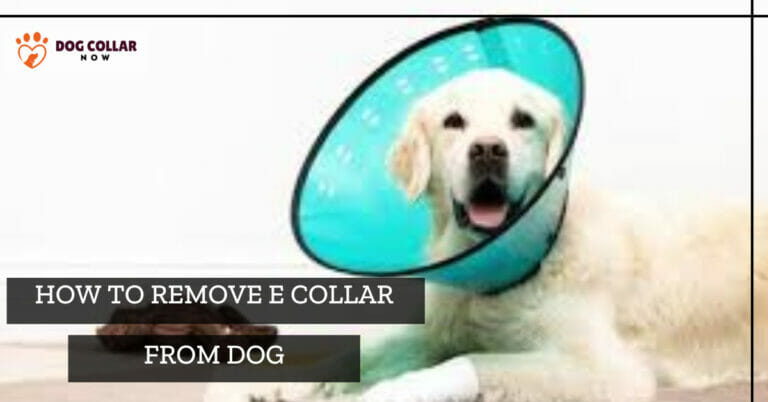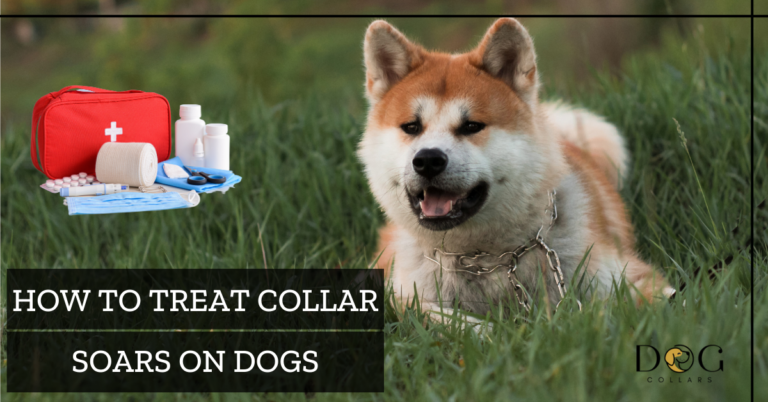Flea Collar Vs Topical For Dogs – Unlock the Secret

Dogs are lovely animals that bring joy to our homes, but they can also be carriers of fleas, microscopic parasites that can cause great discomfort to our furry friends.
When it comes to protecting our furry friends from fleas, two commonly used options are flea collars and topical treatments. Each method has its own benefits and considerations.
Flea collars provide long-lasting protection against fleas and ticks, while topical treatments offer targeted and fast-acting flea control for dogs.
In this informative guide, we will explore the differences between flea collars and topical treatments for dogs, helping you make an informed decision about which approach is best for your beloved pet.
Flea Collar Vs Topical For Dogs – What’s The Difference Between
Here are the main differences between flea collars and topical treatments for dogs:
- Application Method:
- Flea Collar: It is a wearable collar that is placed around the dog’s neck.
- Topical Treatment: It is a liquid solution that is applied directly to the dog’s skin, usually between the shoulder blades or at the base of the neck
- Duration of Effectiveness:
- Flea Collar: It provides long-lasting protection, typically ranging from several weeks up to several months.
- Topical Treatment: It offers immediate and fast-acting relief, but the effects may last for a shorter duration, usually a few weeks.
- Coverage and Targeting:
- Flea Collar: It covers a larger area of the dog’s body, offering more comprehensive protection against fleas and tick collars.
- Topical Treatment: It specifically targets the area where it is applied, providing localized and targeted flea control.
- Water Resistance:
- Flea Collar: Some flea collars are water-resistant, allowing dogs to swim or bathe without reducing the collar’s effectiveness.
- Topical Treatment: The effectiveness of topical treatments may diminish if the dog gets wet or is exposed to water shortly after application.
- Convenience and Ease of Use:
- Flea Collar: Once it is properly fitted, the collar remains on the dog and requires minimal maintenance or reapplication.
- Topical Treatment: It requires monthly or regular application, which can be a simple process but needs to be repeated.
By considering these differences, you can choose the option that best suits your dog’s needs and your preferences for topical flea treatment.
Flea Collars Of Dogs
Pros and Cons
| Pros of Flea Collars | Cons of Flea Collars |
| Easy to use and convenient | Some dogs may be sensitive to the chemicals |
| Long-lasting protection | May not immediately eliminate existing fleas |
| No need for regular application or pills | Not all flea collars are equally effective |
| Some collars contain natural ingredients | Synthetic collars can irritate skin allergies |
Types of Flea Collars
There are two main types of flea collars for dogs: traditional and natural.
- Traditional flea collars use chemicals to repel fleas and ticks, while natural flea collars use essential oils.
- Traditional collars contain insecticides that kill fleas on contact and prevent future infestations.
- Some pet owners have concerns about the chemicals in traditional flea collars and potential allergic reactions.
- Natural flea collars offer a chemical-free option using essential oils that repel fleas and soothe irritated skin.
- Both types of flea collars can be effective, so choose based on your preferences and your dog’s specific needs.
Topical Collars
Pros and Cons
| Pros | Cons |
| Effective in killing fleas and ticks on contact | Potential for adverse reactions in some dogs |
| Longer-lasting protection | Chemicals may cause itching or hair loss |
| Does not interfere with daily activities | Children may come into contact with chemicals |
Types of Topical Collars
- Spot-On Treatments: These are applied directly to a specific spot on your dog’s skin, usually between the shoulder blades. They provide localized protection against fleas and ticks.
- Sustained Release Topical Collars: These collars slowly release active ingredients over time, providing continuous protection against pests. They are convenient and require less frequent application compared to other topical treatments.
- Waterproof Topical Collars: Designed to withstand exposure to water, these collars remain effective even after bathing or swimming. They are ideal for active dogs or those living in humid environments.
- Prescription Topical Collars: These collars are available through veterinarians and contain stronger active ingredients to combat severe adult fleas and tick infestations. They are recommended for dogs with specific health conditions or higher exposure risks.
- Natural Topical Collars: Made with plant-based ingredients, natural topical collars offer an alternative to chemical-based treatments. They repel pests using essential oils, such as citronella or eucalyptus while being gentle on your dog’s skin.
Each type of topical collar provides a different approach to topical flea and tick prevention from pesticide, allowing pet owners to choose the most suitable option based on their dog’s needs and preferences.
Factors to Consider When Choosing Between Flea Collars and Topical Treatments
Lifestyle and Habits
When choosing between dog flea collars and topical treatments, it’s important to consider your lifestyle and habits. For example, if your dog loves to swim or bathe frequently, a flea collar may not be the best option, as it could lose effectiveness when exposed to water.
On the other hand, if your dog likes to play rough and roll around in dirt and grass, a collar may be a better option, as it cannot be easily rubbed off or washed away.
Budget
The cost of flea prevention options can vary greatly, with some treatments costing as little as a few dollars and others costing several hundred dollars per year. When deciding between flea collars and topical treatments, it’s important to consider your budget and choose a product that provides the right balance of cost and effectiveness.
Effectiveness And Speed Of Action
Both flea collars and topical treatments are effective at controlling flea infestations, but they may work differently and at different speeds.
Flea collars tend to be slow-acting and may take a few days to start killing fleas, while topical treatments usually start working within a few hours and provide immediate relief. Your choice of flea prevention option should depend on your dog’s needs and your goals for pest control.
Flea Collar Vs Topical For Dogs: What Is The Better Option
The best dog collar for your pup depends upon personal preferences. Your choice of flea prevention option should depend on your dog’s need, your lifestyle and your budget. Flea collars for dogs are designed to provide long-lasting protection against fleas and ticks.
They work by releasing chemical substances that repel and kill these pests, helping to prevent infestations and protect your dog’s well-being. Having used flea collars on my own dogs, I appreciate their convenience and effectiveness in keeping my furry companions free from fleas and ticks for extended periods.
On the other hand Topical treatments, such as spot-on products, are applied directly to your dog’s skin, typically between the shoulder blades. They work by spreading through the skin’s oils, effectively killing fleas and ticks upon contact. Personally, I’ve found topical treatments to be highly effective in controlling and preventing flea and tick infestations
Conclusion
In conclusion, both flea collars and topical treatments are effective options for preventing fleas and other pests in dogs. As always, it’s important to talk to your veterinarian and choose a product that’s safe and appropriate for your furry friend.
Flea collars provide continuous, long-lasting protection with the convenience of easy application, while topical treatments directly target and eliminate pests on contact.
The choice between the two depends on factors such as personal preference, pet’s individual needs, and any specific concerns regarding chemical exposure. By considering the advantages and potential drawbacks of each option, you can make an informed decision to keep your furry friend healthy and free from pesky parasites.
FAQs:
What are topical treatments?
Topical treatments are spot-on flea and tick medications that are applied directly to a dog’s skin. These flea treatments can kill and repel fleas and ticks.
What are the types of flea collars?
There are two types of flea collars: chemical flea collars that release pesticides and ultrasonic flea collars that use ultrasonic waves to repel fleas and ticks. However, the ultrasonic flea collars are not as effective as the chemical ones.
What are the types of topical treatments?
There are different types of topical flea and tick treatments, such as flea drops, flea medicines, and topical products. Spot-on treatments are applied on the back of the dog’s neck and the medication spreads throughout the dog’s body.
How do flea collars work?
Flea collars work by releasing chemicals that kill fleas and ticks. Some flea collars have a long-lasting effect, while others need to be replaced after a certain amount of time. Seresto is an example of a flea collar that can last up to 8 months. However, it’s important to note that some dogs may have an allergic reaction to the flea collar.
How do topical treatments work?
Topical flea and tick treatments contain an active ingredient that spreads throughout the dog’s body. The medication can kill adult fleas and ticks, as well as prevent flea eggs from hatching. Topical treatments can last up to a month, depending on the product.
Which one is better, flea collar or topical treatment?
It depends on the dog’s individual needs and preferences. Flea collars are easy to use and can provide long-lasting flea protection. However, some dogs may not like wearing a flea collar, and it may not be effective in preventing flea infestation. Topical treatments can be effective in killing flea.








